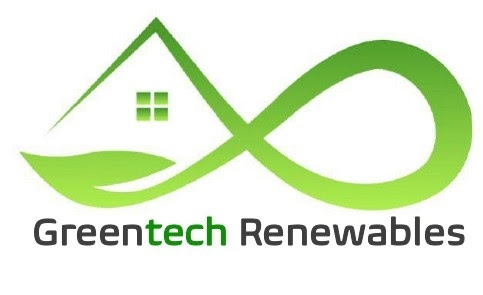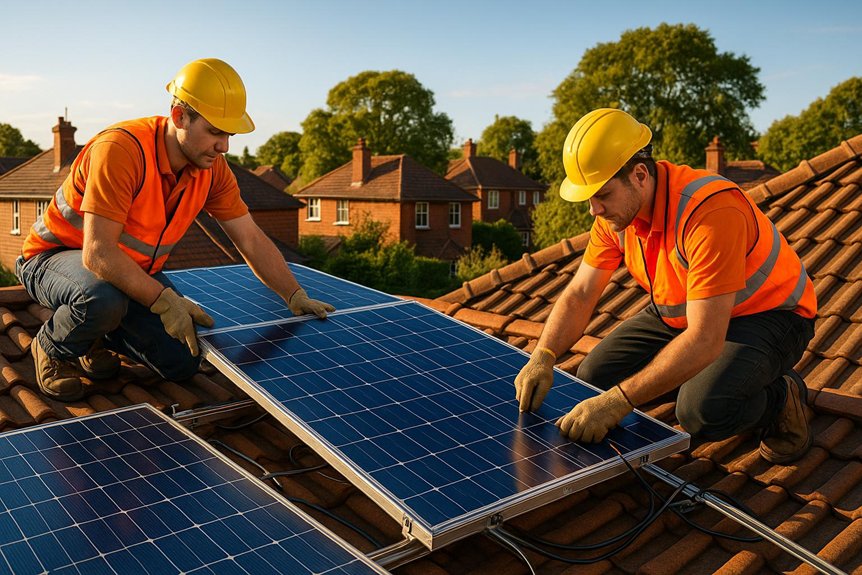If you install high-efficiency, certified solar panels in Malvern, you can cut your energy costs by up to £400 annually and increase your property’s market value. Monocrystalline panels offer over 22% efficiency and last more than 25 years. Government grants and tax benefits can offset upfront expenses, while professional installers guarantee ideal placement and system reliability. With low maintenance and significant environmental benefits, your investment will pay off steadily. Further details on customization and savings await your exploration.
Benefits of Solar Panels for Malvern Homeowners
Although the initial investment in solar panels may seem substantial, Malvern homeowners can save up to £400 annually on energy bills, which considerably lowers their long-term energy expenses. Solar panels typically last over 25 years, ensuring a reliable and sustained source of renewable energy. This longevity translates into significant cumulative savings by reducing reliance on traditional electricity sources. Additionally, installing solar panels can increase your property’s market value, making it more appealing to potential buyers in Malvern’s competitive real estate market. You can also take advantage of government grants, tax benefits, and rebates that ease the upfront costs, making the installation more affordable. Modern photovoltaic panels, converting over 22% of sunlight into electricity, provide consistent and predictable energy output, enhancing the overall efficiency of your solar investment. Furthermore, government grants and tax incentives offer financial support that reduces initial setup costs for homeowners.
High-Efficiency Solar Panel Technologies Available
When choosing between monocrystalline and polycrystalline panels, you’ll find that monocrystalline models typically offer higher efficiency and better performance under various conditions. You should also consider advanced innovations like bifacial panels, which capture sunlight from both sides, and solar tracking systems that adjust angles to maximize exposure throughout the day. These technologies can greatly boost your system’s overall energy output, making them worth evaluating for your installation. Additionally, incorporating cutting-edge solutions can further enhance the effectiveness and reliability of your solar energy system.
Monocrystalline Vs Polycrystalline
Since choosing the right solar panel technology considerably impacts both efficiency and cost, understanding the differences between monocrystalline and polycrystalline panels is essential. Monocrystalline panels, made from a single crystal structure, offer efficiency rates exceeding 22%, outperforming polycrystalline panels, which range between 15% and 20%. However, monocrystalline panels cost more due to their energy-intensive manufacturing process, while polycrystalline panels are more affordable and environmentally friendly to produce. You’ll find monocrystalline panels perform better in low light and have a longer lifespan, making them ideal for limited sunlight locations. Additionally, they require less space to generate equivalent energy, which benefits residential installations with restricted roof area. Polycrystalline panels, though less efficient, remain a practical choice when budget and environmental impact are primary concerns.
Advanced Panel Innovations
Advancements in solar panel technology have greatly increased the efficiency and versatility of modern systems, allowing you to maximize energy production even in limited spaces. High-efficiency monocrystalline panels now convert over 22% of sunlight into electricity, optimizing residential energy output. Innovations such as bifacial panels and tracking systems capture additional sunlight by utilizing both sides of the panel and adjusting orientation throughout the day, respectively, boosting overall yield beyond traditional fixed setups. Additionally, thin-film technologies provide lightweight, flexible options suitable for varied roof types and orientations. Continuous research has enhanced performance in adverse weather, ensuring consistent generation year-round. Moreover, cutting-edge materials improve durability and efficiency, with panels lasting over 25 years and requiring minimal maintenance, making these advanced technologies a practical investment for long-term energy solutions.
Financial Incentives and Grants for Solar Installation
Financial incentives and grants play an essential role in making solar panel installations more accessible and economically viable for homeowners. Various governments offer grants, tax benefits, and rebates that reduce the initial investment required, directly lowering upfront costs. These financial incentives shorten the payback period for solar systems, which improves overall profitability. Additionally, programs like renewable energy certificates and local rebates further decrease installation expenses. By taking advantage of these benefits, you not only save on energy bills long term but also enhance your property’s value through energy-efficient improvements. Understanding and utilizing available incentives allows you to make a more informed decision, ensuring your investment in solar technology yields stable financial returns while contributing to sustainable energy adoption in Malvern. Furthermore, considering the cost of hiring a solar panel installer can help you better gauge the potential savings from these financial incentives.
Choosing Certified Solar Installers in Malvern
When you choose certified solar installers in Malvern, you confirm that your project meets strict compliance standards and benefits from experienced professionals who understand local regulations. These certified experts conduct detailed site assessments, optimizing panel placement to maximize energy output based on Malvern’s sunlight patterns. Their accreditation also guarantees access to quality technology and financial incentives, making your installation both reliable and cost-effective.
Certification Importance
Although selecting a solar installer might seem straightforward, choosing certified professionals in Malvern is essential for ensuring compliance with industry standards and regulations, which safeguards both safety and quality. Certified installers have completed rigorous training, equipping them with the expertise needed to install solar systems efficiently and maximize energy output. By working with certified professionals, you gain access to warranties and reliable aftercare services, which support long-term system maintenance. Moreover, certification from recognized bodies often signals the use of high-quality materials and advanced technology, enhancing your solar panel’s performance and durability. Additionally, employing certified installers may make you eligible for government grants and financial incentives, reducing your overall installation costs and improving the economic viability of your solar energy investment.
Installer Experience
Since the effectiveness of your solar panel system heavily depends on its installation, selecting certified installers with extensive experience in Malvern is essential. Certified professionals have undergone rigorous training and assessments, ensuring they stay current with the latest technology and installation methods. They conduct thorough site assessments to optimize panel positioning, maximizing energy production tailored to Malvern’s sunlight conditions. Additionally, experienced installers offer reliable post-installation support and understand local financial incentives that can reduce your costs. When choosing installers, consider:
- Their certification status and training background
- Customer reviews highlighting work quality and punctuality
- Knowledge of local grants and tax benefits
Compliance Standards
Guaranteeing compliance with industry standards and local regulations is essential when selecting a solar installer in Malvern, as certified professionals have the qualifications and training necessary to uphold these requirements. Certified installers guarantee safe, efficient installations that meet UK renewable energy regulations, reflecting best practices in solar technology and service quality. Additionally, they often provide warranties and aftercare services, offering long-term maintenance and support for your solar system. Choosing accredited installers also improves system reliability and performance while facilitating access to government grants, tax benefits, and incentives that reduce installation costs. By prioritizing certified professionals, you guarantee your solar panel system not only complies with legal standards but also delivers peak efficiency and financial advantages, making your investment both secure and cost-effective.
Customizing Solar Systems for Residential Needs
When you customize a solar system for your home, you need to contemplate several key factors to maximize both efficiency and cost savings. Your household’s energy consumption patterns serve as the foundation for tailoring the system, ensuring it meets demand without excess. Evaluating roof orientation, shading, and Malvern’s local climate conditions allows for ideal panel placement and energy production. Additionally, selecting between monocrystalline or polycrystalline panels will depend on your efficiency goals and budget constraints. Greentech Renewables provides personalized consultations to align your solar solution with these considerations. Key customization factors include:
- Examining roof characteristics and sunlight exposure
- Analyzing household energy usage patterns
- Choosing panel types based on efficiency and cost
This targeted approach enhances performance and economic benefits for your residential solar installation.
Integration of Battery Storage Solutions
Although solar panels generate clean energy during daylight hours, integrating battery storage solutions allows you to store surplus electricity for use when the sun isn’t shining, thereby increasing your energy independence and overall system efficiency. By combining battery systems with your solar installation, you can maximize savings by utilizing stored energy during peak demand periods, reducing reliance on the grid. Advanced batteries offer real-time data on production and consumption, enabling you to monitor and optimize energy usage effectively. Additionally, many modern storage solutions support remote programming and seamless updates, simplifying management. This integration greatly improves the return on investment by extending solar energy utility beyond daylight hours, making your system more versatile and economically beneficial over time.
Environmental Impact of Solar Energy Adoption
Because solar energy adoption directly reduces reliance on fossil fuels, it markedly lowers carbon emissions, which helps mitigate the effects of climate change. By switching to solar panels, you can decrease your household’s carbon footprint by up to 80% compared to traditional energy sources. Additionally, solar power production uses minimal water, conserving essential resources and reducing environmental strain. Beyond emissions and water savings, solar energy also improves air quality by cutting down pollutants linked to respiratory issues and smog. Furthermore, it supports biodiversity by lessening habitat disruption caused by fossil fuel extraction. Key environmental benefits include:
- Significant reduction in greenhouse gas emissions
- Minimal water consumption during energy generation
- Enhanced air quality and preservation of natural habitats
Adopting solar energy offers a substantial, measurable positive impact on the environment.
Maintenance and Longevity of Solar Panel Systems
Solar panel systems offer a reliable source of renewable energy, but their long-term performance depends on proper care and regular monitoring. Typically lasting over 25 years, solar panels require minimal maintenance, mainly occasional cleaning to sustain peak efficiency. Factors such as shading, weather, and panel positioning can affect their performance, so periodic assessments are essential to identify and resolve any issues. Most panels come with extensive warranties, like the 25-year coverage from Panasonic and Tesla, which protect against major repairs. Ensuring your system’s longevity also involves utilizing thorough aftercare services provided by professional installers, such as Greentech Renewables, who monitor operational efficiency and address potential problems promptly. By adhering to these maintenance practices, you can maximize your solar investment’s lifespan and energy output.
Calculating Energy Savings and Payback Periods
When evaluating the financial benefits of installing solar panels, calculating your potential energy savings and the associated payback period is essential. You’ll start by reviewing your annual energy consumption and estimating savings, noting that households in nearby regions save up to £400 yearly. Using an interactive calculator tailored to your usage and local sunlight levels can help estimate the payback period, which generally ranges from 5 to 12 years. Factors influencing these calculations include panel efficiency, system size, and available government incentives.
Key points to reflect on:
- Annual energy savings depend on consumption and sunlight exposure.
- Payback periods vary with initial costs, incentives, and electricity prices.
- Financial benefits like grants can greatly reduce the time to recoup your investment.


